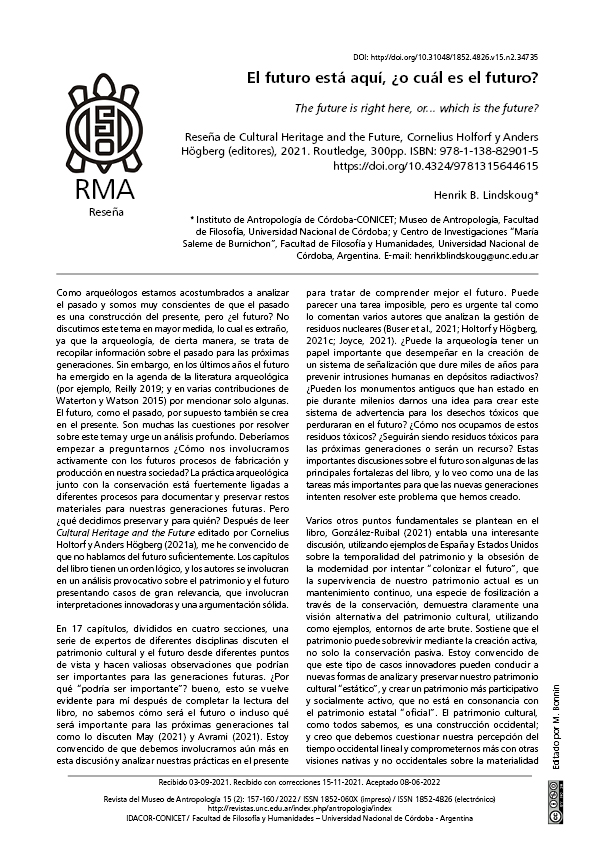The future is right here, or... which is the future?
DOI:
https://doi.org/10.31048/1852.4826.v15.n2.34735Abstract
Como arqueólogos estamos acostumbrados a analizar el pasado y somos muy conscientes de que el pasado es una construcción del presente, pero ¿Y el futuro? No discutimos este tema en mayor medida, lo cual es extraño, ya que la arqueología, de cierta manera, se trata de recopilar información sobre el pasado para las próximas generaciones. Sin embargo, en los últimos años el futuro ha emergido en la agenda de la literatura arqueológica (por ejemplo, Reilly 2019; y en varias contribuciones de Waterton y Watson 2015) por mencionar solo algunas. El futuro, como el pasado, por supuesto también se crea en el presente. Son muchas las cuestiones por resolver sobre este tema y urge un análisis profundo. Deberíamos empezar a preguntarnos ¿Cómo nos involucramos activamente con los futuros procesos de fabricación y producción en nuestra sociedad? La práctica arqueológica junto con la conservación está fuertemente ligadas a diferentes procesos para documentar y preservar restos materiales para nuestras generaciones futuras. Pero ¿qué decidimos preservar y para quién? Después de leer Cultural Heritage and the Future editado por Cornelius Holtorf y Anders Högberg (2021a), me he convencido de que no hablamos del futuro suficientemente. Los capítulos del libro tienen un orden lógico, y los autores se involucran en un análisis provocativo sobre el patrimonio y el futuro presentando casos de gran relevancia, que involucran interpretaciones innovadoras y una argumentación sólida.
Downloads
References
Avrami, E. (2021). Sustainability, intergenerational equity, and pluralism: Can heritage conservation create alternative futures? En C. Holtorf y A. Högberg (Eds.), Cultural Heritage and the Future (pp. 198-216). Routledge.
Buser, M., Van Luik, A., Nelson, R., y Holtorf, C. (2021). Radioactive heritage of the future: A legacy of risk. En C. Holtorf y A. Högberg (Eds.), Cultural Heritage and the Future (pp. 176-197). Routledge.
Dixon, J. (2021). The spectre of non-completion: An archaeological approach to half-built buildings. En C. Holtorf y A. Högberg (Eds.), Cultural Heritage and the Future (pp. 103-119). Routledge.
González-Ruibal, A. (2021). Decolonizing the future: Folk art environments and the temporality of heritage. En C. Holtorf y A. Högberg (Eds.), Cultural Heritage and the Future (pp. 87-102). Routledge.
Holforf, C., y Högberg, A. (Eds.). (2021a). Cultural Heritage and the Future, Routledge. https://doi.org/10.4324/9781315644615
Holtorf, C., y Högberg, A. (2021b). Introduction: Cultural heritage as a futuristic field. En C. Holtorf y A. Högberg (Eds.), Cultural Heritage and the Future (pp. 1-28). Routledge.
Holtorf, C., y Högberg, A. (2021c). What lies ahead? Nuclear waste as cultural heritage of the future. En C. Holtorf y A. Högberg (Eds.), Cultural Heritage and the Future (pp. 144-158). Routledge.
Joyce, R. A. (2021). The future in the past, the past in the future. En C. Holtorf y A. Högberg (Eds.), Cultural Heritage and the Future (pp. 159-175). Routledge.
Lindskoug, H. B., y Marschoff, M. (2022). Dilemas de la modernidad: práctica y teoría de la arqueología de contrato en Córdoba, Argentina. Revista del Museo de Antropología, 15(1), 31–44. https://doi.org/10.31048/1852.4826.v15.n1.33785
Lindskoug, H. B., y Martínez, W. (2022). Contemporary archaeology in conflict zones: The materiality of violence and the transformation of the urban space in Temuco, Chile during the social outburst. Journal of Material Culture, https://doi.org/10.1177%2F13591835221074167 .
Márquez, F. (2020). Por una antropología de los escombros. El estallido social el Plaza Dignidad, Santiago de Chile. Revista 180, 45, 1-13. http://dx.doi.org/10.32995/rev180.Num–45.(2020).art–717
Marschoff, M., Lindskoug, H. B., y Gabriel, V. (2022). Procesos de Patrimonialización en acción en la ciudad de Córdoba, Argentina. Comechingonia. Revista de Arqueología, 26(1), 89-113. https://doi.org/10.37603/2250.7728.v26.n1.32995
May, S. (2021). Heritage, thrift, and our children’s children. En C. Holtorf y A. Högberg (Eds.), Cultural Heritage and the Future (pp. 46-58). Routledge.
Reilly, M. (2019). Futurity, Time, and Archaeology. Journal of Contemporary Archaeology, 6(1), 1-15. https://doi.org/10.1558/jca.36830
Sabato, E. (Ed.). (1984). Nunca Más. informe de la Comisión Nacional sobre la desaparición de personas. Eudeba.
Salerno, M. A., Zarankin, A., y Perosino, M. C. (2015). Arqueologías de la clandestinidad. Una revisión de los trabajos efectuados en los centros de detención clandestinos de la última dictadura militar en Argentina. Revista Universitaria de Historia Militar, 1(2), 49-84. http://ruhm.es/index.php/RUHM/article/view/19
Tello, M. E. (2012). (Sobre)vidas: objetos, memorias e identidades en la transmisión de experiencias concentracionarias. Revista Del Museo De Antropología, 5(1), 141-148. https://doi.org/10.31048/1852.4826.v5.n1.9133
Waterton, E., y Watson, S. (Eds.). (2015). The Palgrave Handbook of Contemporary Heritage Research. Palgrave Macmillan. https://doi.org/10.1057/9781137293565

Downloads
Published
Issue
Section
License
Copyright (c) 2022 Henrik Bernhard Lindskoug

This work is licensed under a Creative Commons Attribution-NonCommercial-ShareAlike 4.0 International License.
Those authors who have publications with this Journalaccept the following terms:
a. Authors will retain their copyrights and guarantee the journal the right of first publication of their work, which will be simultaneously subject to the Creative Commons Attribution License (Licencia de reconocimiento de Creative Commons) that allows third parties to share the work as long as its author and his first publication in this journal.
b. Authors may adopt other non-exclusive licensing agreements for the distribution of the version of the published work (eg, deposit it in an institutional electronic file or publish it in a monographic volume) provided that the initial publication in this journal is indicated.
c. Authors are allowed and recommended to disseminate their work on the Internet (eg in institutional telematic archives or on their website) before and during the submission process, which can lead to interesting exchanges and increase citations of the published work. (See The Effect of Open Access - El efecto del acceso abierto)











